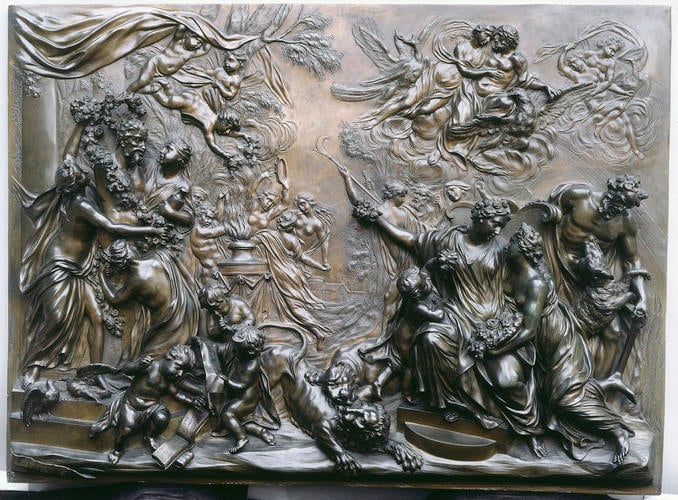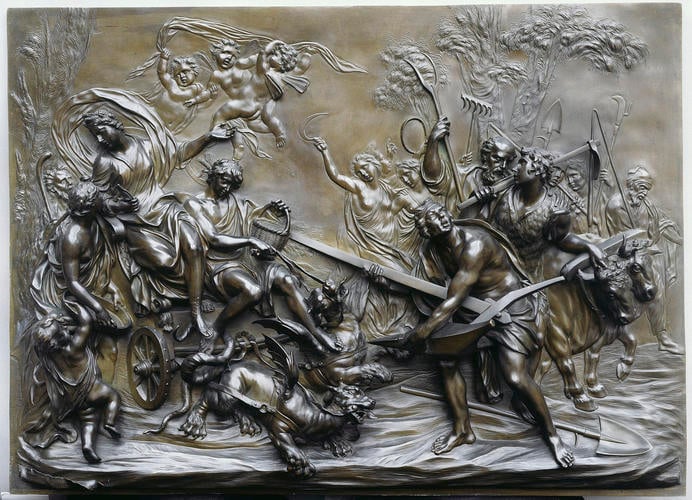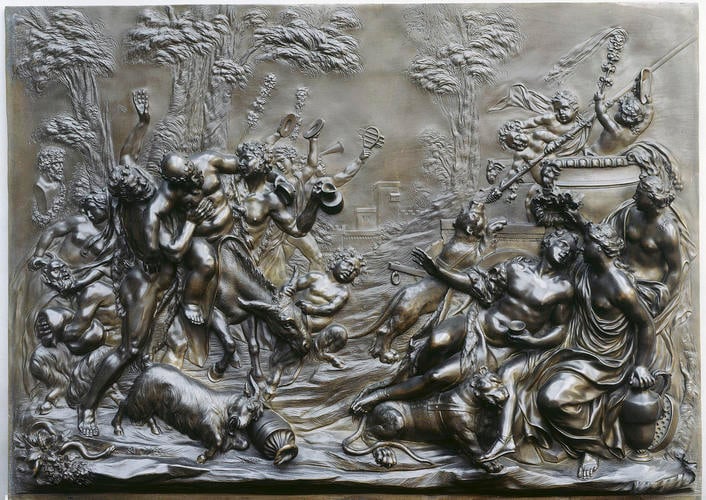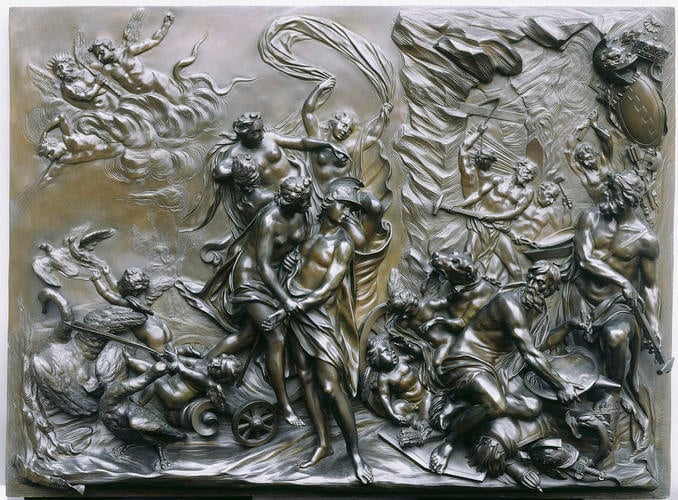-
1 of 253523 objects
The Four Seasons - Spring, Summer, Autumn, Winter 1715
Cast bronze with ebonised pearwood frames | 48 x 66.3 cm (whole object) | RCIN 21932

Massimiliano Soldani-Benzi (1656-1740)
Master: The Four Seasons - Spring, Summer, Autumn, Winter 1715

Massimiliano Soldani-Benzi (1656-1740)
Master: The Four Seasons - Spring, Summer, Autumn, Winter 1715

Massimiliano Soldani-Benzi (1656-1740)
Master: The Four Seasons - Spring, Summer, Autumn, Winter 1715




-
A set of four bronze reliefs with an even brownish-black patina of the Four Seasons, depicted through Classical reference - .1 Flora as Spring; .2 Ceres as Summer; .3 Silenus as Autumn; .4 Vulcan as Winter.
The medallist and sculptor Massimiliano Soldani-Benzi dominated Florentine sculpture in the late baroque period, working throughout his life for the ruling Medici family. The origin of these superb reliefs can be found in a commission of 1708 from Crown Prince Ferdinando de’Medici, heir to Cosimo III, Grand Duke of Tuscany, for two reliefs, representing Summer and Autumn, intended for presentation to the Crown Prince’s brother-in-law, Johann-Wilhelm, Elector Palatine. These two were soon joined by reliefs representing Spring and Winter, completed in 1711.
The reliefs were composed in clay, and the models then used to make piece-moulds from which the bronzes would eventually be cast by the lost-wax process. The clay models were fired for the purpose of preservation and remain in Palazzo Pitti, Florence, in their original glazed frames. When first completed in bronze, the reliefs would have had a golden surface, imparted by powdered haematite suspended in an oil varnish . Soldani’s technique was designed to enable further casts to be made, and through adjustments at the wax stage he could add armorials or mottos specific to the patron concerned. In April 1715 the 21-year-old Lord Burlington visited Soldani’s studio during his Grand Tour, and purchased casts of the Summer and Autumn reliefs for £125 each, leaving a commission for Spring and Winter. These were embellished with Burlington’s arms and short verse inscriptions from Virgil’s Aeneid, one of which (on Spring) substitutes ‘Burlingtonus’ for ‘Marcellus’.
In a manuscript addition to George Vertue’s 1758 description of Queen Caroline’s Closet at Kensington, Horace Walpole noted ‘… In the King’s Bedchamber … some Bronze pictures, presented to George 2d by Ld Burlington’. Vertue himself had earlier noted, at the sale of the 2nd Earl of Radnor’s possessions at his house in St James’s Square in 1723, ‘…four fine pieces in Brass guilt with gold. being alto relievo’s by Max: Soldani.1715 / many figures raised quite out from the flatt’. This reference, likely to refer to the Four Seasons, is puzzling, as no other evidence has come to light for the existence of a third complete set.
If we accept Walpole’s word, we must assume that the significance of the Latin inscriptions went unnoticed by the King. The gift seems most likely to have taken place between 1730, when Burlington was invested as a Knight of the Garter, and 1733, when he resigned all his public positions in protest at being passed over for one of the higher offices of State.
The first set of casts made for the Elector (Munich, Bayerisches Nationalmuseum) were displayed in ebony and gilt bronze frames and hung alongside the paintings in the gallery at the electoral palace in Düsseldorf. It is not known how the present set was first framed, but in 1814, when they were still kept at Kensington Palace, they were described as having ‘black frames’.
The original set, dated 1708 and 1711 are in the National Museum, Munich. A pair of Summer and Autumn plaques are in the Helen Foresman Spencer Museum of Art, Kansas.
Text adapted from The First Georgians: Art and Monarchy 1714 - 1760, London, 2014Provenance
Summer and Autumn purchased from the artist in Florence in February 1715 by Richard Boyle, 3rd Earl of Burlington (1694-1753); Spring and Winter commissioned at the same time but delivered subsequently; all four reliefs presented by Burlington to George II.
-
Creator(s)
(nationality)Acquirer(s)
-
Medium and techniques
Cast bronze with ebonised pearwood frames
Measurements
48 x 66.3 cm (whole object)